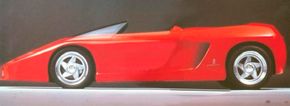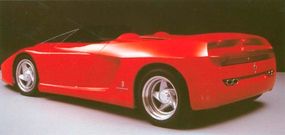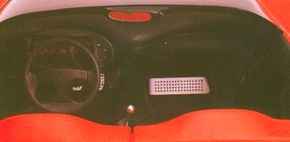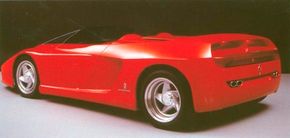With the introduction of the 1989 Ferrari Mythos concept car, the fabled styling house Pininfarina broke tradition and declined to debut latest creation in Europe.
Instead, the company chose Tokyo's October 1989 auto show to unveil what may have been its most striking design study ever. Created for Ferrari, cementing the decades-long tie between the two companies, the Mythos was no myth, no fantasy. It was a real no-top speedster with a mid-rear 12-cylinder engine. Yet neither did it quite qualify as reality. Not for a while, at any rate.
Advertisement
Although based on the proven Testarossa chassis, the Ferrari Mythos concept car was strictly one-of-a-kind, playing on its own field. And yet, said chief designer Lorenzo Ramaciotti, the car's design could be "adapted to fill the needs of production... of tomorrow's cars." Sergio Pininfarina, the company chairman, called it an "advanced research prototype," meant to show that Italian styling was "on the crest of the wave."
There was not much doubt about that. Even superlatives seemed lacking when describing the lines of the Ferrari Mythos concept car. Best? Smoothest? Most beautiful? Maybe so; but more important, Mythos signaled a switch in basic approach to auto design, from the reality-based creations of recent times (which focused on new materials and technologies) back to the dreamy, elemental essences of form. In a word, it was a return to the "purity" of the dream.
Emphasizing the "relationship between volumes," according to the Pininfarina firm, the Ferrari Mythos concept car broke free of the traditional "linked panels." Although made up of two distinct elements, the stylists attempted to meld the pair into a single homogeneous form, one flowing into the other.
The main body, containing engine and rear-mounted radiators, served as one of the two masses. The extension that holds passengers and the car's nose was the other. Unlike the Testarossa, which used lateral grilles to minimize the relation of the two masses, Mythos tried to emphasize that contrast -- to highlight the obvious fact that they intersected.
The 1989 Ferrari Mythos concept car broke free from tradition in other ways, as we'll see on the next page.
For more on concept cars and the production models they forecast, check out:
- Concept Cars
- Future Cars
- Consumer Guide auto show reports
- Classic Cars
Advertisement




